

Investigating the Dates on Cartridges
By John Earney
In Scott Stilphen's Atari VCS Cartridge Label Variations FAQ, he writes: "Many carts have numbers or letters stamped onto the end labels. It's possible that certain production facilities used these, but for what reason?" I didn't get this information from Atari or anything, but I do know what the numbers mean. The number indicates when the cart was manufactured. There are three digits in the number. The last digit indicates what year the cart was manufactured and the first two digits indicate what week of that year the cart was made. For example: a cart has "453" stamped on it. So this cart was made in the 45th week of 1983.
Notice that the first two digits can't be greater than 52. Since the summer of 1991, when I first came up with this theory about the numbers being a date, I haven't found a single cart whose first two digits were greater than 52. Also you can compare the earliest date on a particular game's carts to the catalog that the game first appeared in. Based on all that evidence (and a bit more stated below) I think my theory is correct. Sometimes there is an "E" before the number and sometimes there is an "R" or a "D" after the number. I don't know what those letters indicate. My guess is that they indicate which production facility made the cart. Anyone know?
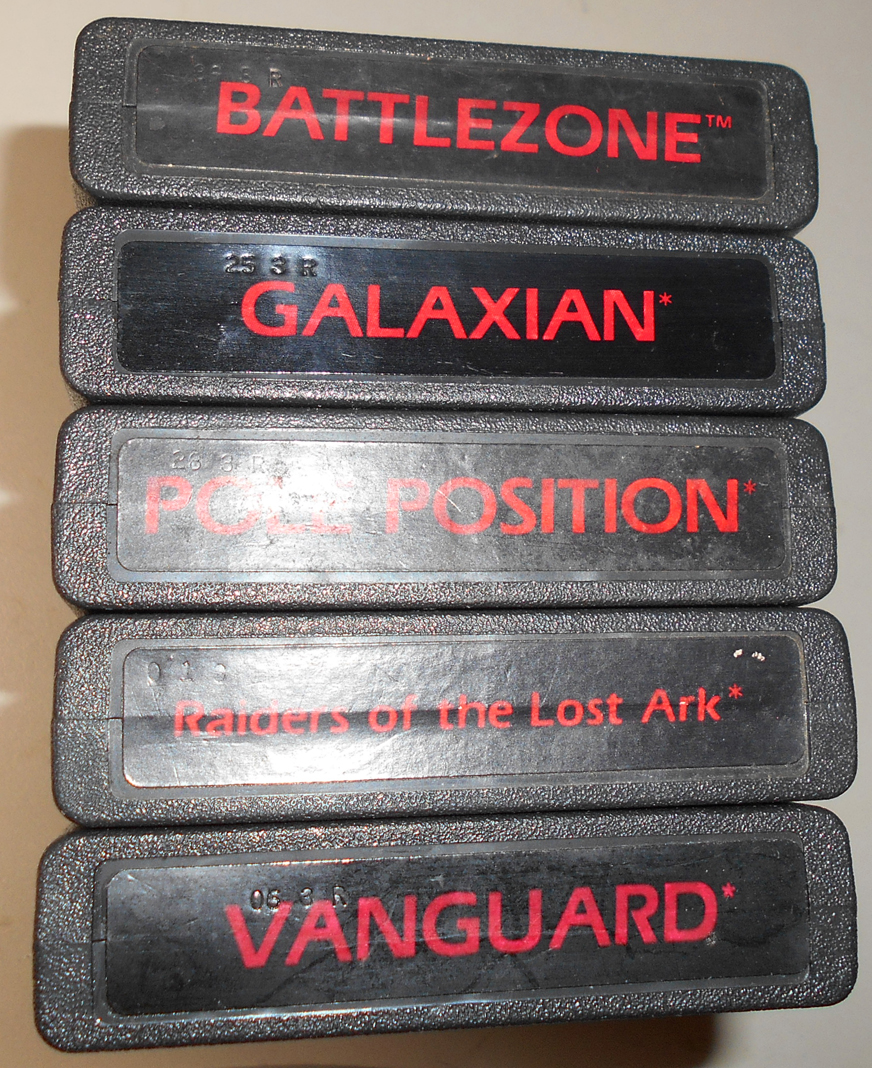
Actually if you don't mind opening things up, you can find out when just about anything in your collection was made. Most integrated circuits (ICs) have their date of manufacture printed on top (integrated circuits are those flat black rectangular components that you'll find on most circuit boards). The date that's printed on ICs is always a four digit number and it usually is by itself (although sometimes there's a few letters before or after the numbers). The first two digits indicate which
year it was made and the last two digits indicate which week of that year it was made. 7935 would mean the 35th week of 1979. It may take a bit of practice before you can spot the date because there's typically a lot of writing on ICs. Here -- I'll bust open a Combat cartridge as an example.
OK - here's what's written on the IC:
AMI 8141MAV
C011201-01
(c)1978 ATARI
PHILIPPINES
This particular IC (a ROM in this case) was manufactured during the 41st week of 1981. Keep in mind that the final product would have been made after this. The number printed on the end label for this cart was 202, so it took 31 weeks for them to get the ROM put into a cartridge. That's quite a bit longer than usual
- they must have ordered a huge amount of Combat ROMs back in 1981!
CAUTION: Sometimes the part number for the IC might look like a date. The part number for the Combat I opened was C011201-01. That doesn't look much like a date, but there is a common family of logic gates whose part numbers look like 74xx. You may see some ICs that say 7404, 7400, 7414, or some other 74xx number. That doesn't mean they were made in 1974!
You should expect to find an IC in any electronic equipment that has to do some amount of "thinking". For example, a joystick or paddle won't have an IC because they're just switches, but there will be one in a cart or game console.
ADDENDUM by Scott Stilphen (7-24-14)
I decided to pick a game (E.T.) from my collection and see how many different dates are stamped on the end labels. Here's what I found out of over 2 dozen carts:
432 - big
452 - big
452R - big
462R - big
472 - big
472D - big
472R - big
482R - big
492 - big
502 - big
502 - small
512 - small
512D - small
The "big" and "small" notes pertain to the 2 different label variations and the size of the diamonds on the ship:
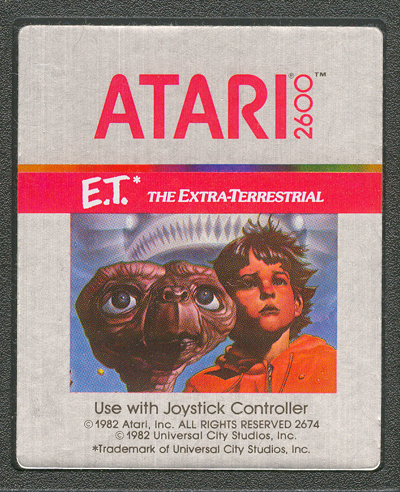
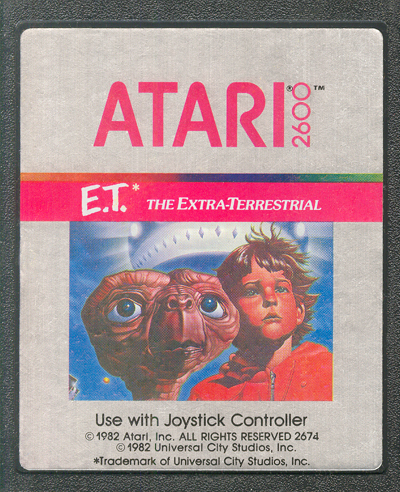
The earliest, 432, would denote the week of October 24th-30th for 1982 (calendar). Atari would have wanted the game to be available in time for "Black Friday", November 26th (it was in my area, as of November 19th ad). The top label variation change happened in the 50th week.
Opening the carts up also revealed something interesting. The earliest carts in the first few weeks of production all had green-colored pcbs, whereas ones made later had gold-colored pcbs:
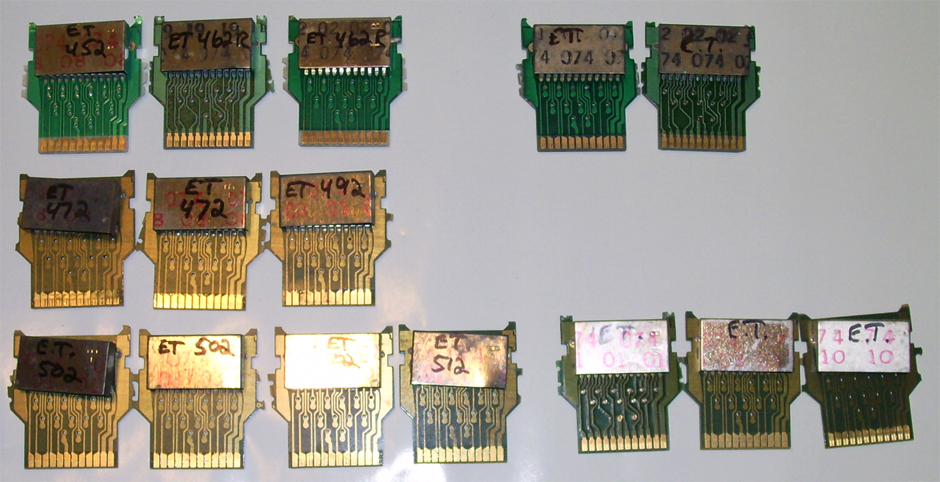
3 of them used COBs (instead of DIPs) - all of which were made in Thailand. The production numbers on those are 8244 and 8246, which would be the 44th and 46th weeks of 1982, although as John Earney noted, these numbers don't match the codes stamped on the end labels (written on the pcb):
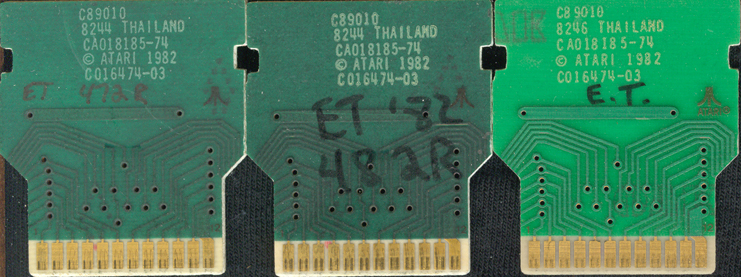
Still, these COBs confirm Atari was one of the first game manufacturers - if not the first - to use COBs in cartridge production. So I decided to look for other games that used COB pcbs. Here's a photo of 5 COB pcbs of games, in the order they were originally released:

Haunted House - February 1982
Pac-Man - March 1982
Defender - June 1982
E.T. December 1982
Centipede - February 1983
The first 3 pcbs are dated 1981, the same date shown onscreen and on the original packaging. The first, Haunted House, is from a re-released cartridge from Atari Corp. and dated 1986! So, much like the packaging and onscreen dates, you can't always rely on the dates printed on the pcbs either. The production numbers on the 5 pcbs are 8247, 8220, 8232, 8244, and 8306. Even though Haunted House had a 1986 copyright date on the label, the pcb was actually produced in the 47th week of 1982. The pcb with the earliest production date, Pac-Man with 8220 (20th week of 1982, or around mid-May), proves just how far ahead Atari was with their competitors in using COB technology.
At least 4 different package types were used by Atari:

The 1st and 3rd types have production dates printed on the bottom of the board, similar to how they're stamped on the end labels, but with the week and year reversed. The 1st seems to be the earliest package used, and games have been produced in more than one COB package. For example. I have copies of Pac-Man in both the 1st and 4th styles, and Pole Position in the 2nd, 3rd, and 4th styles.